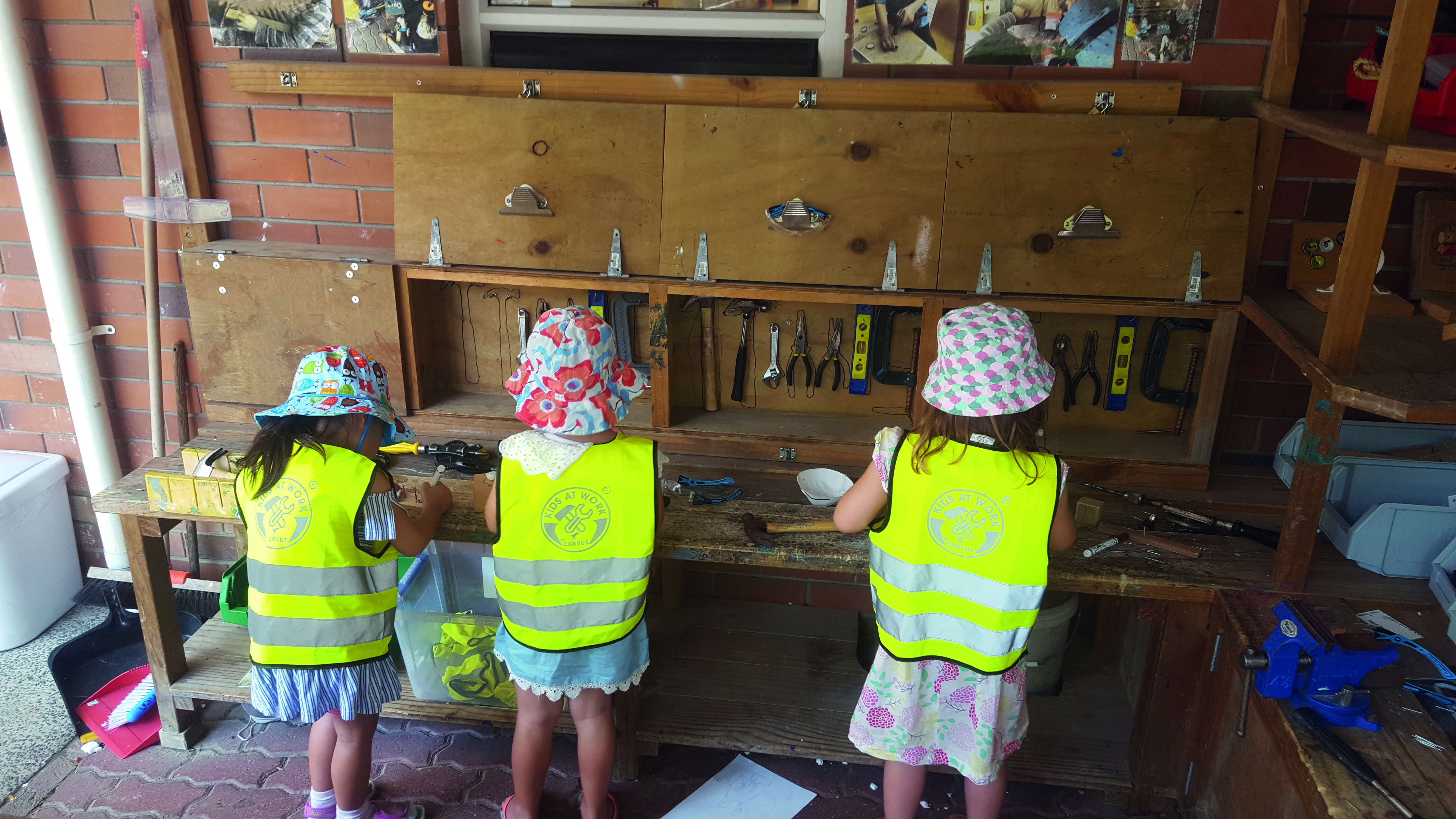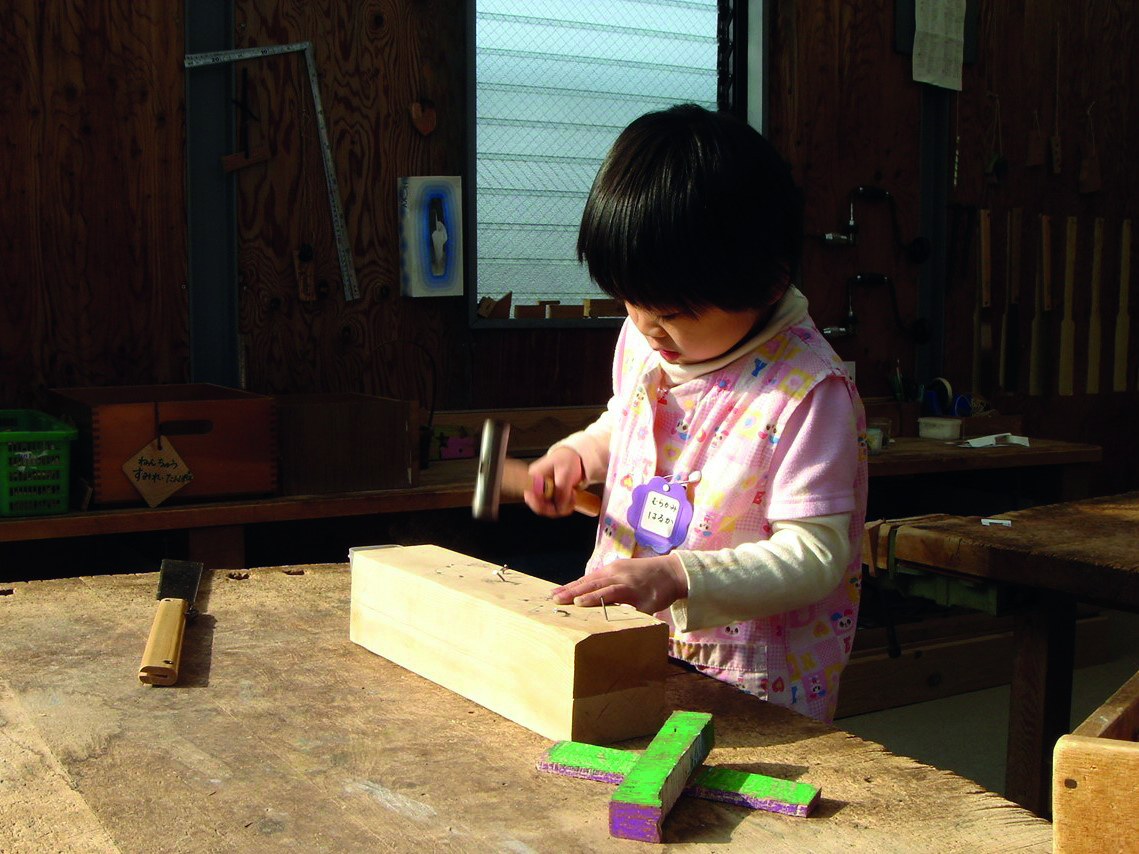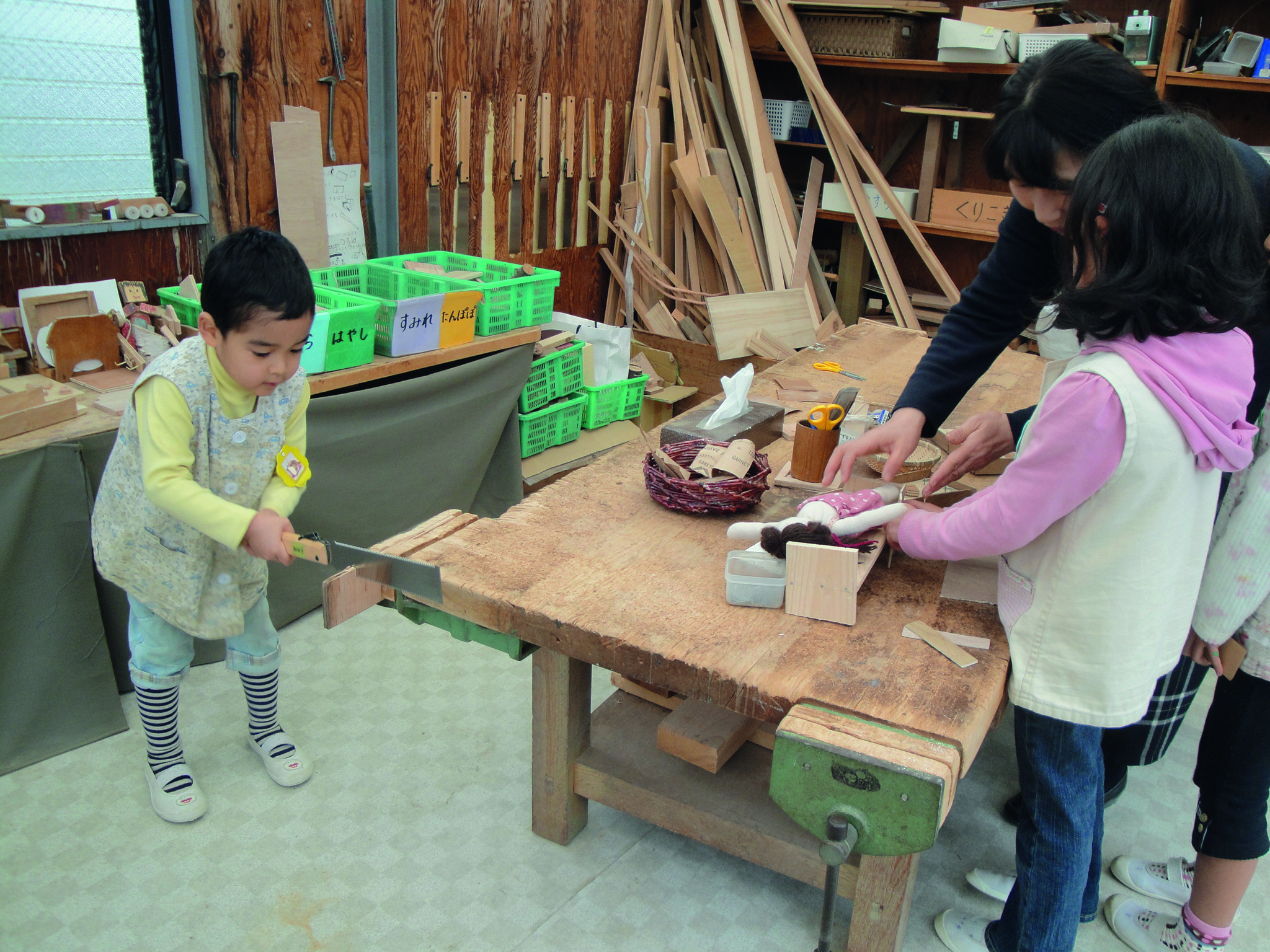
The Winston Churchill Memorial Trust aims to transform aspects of adults’ or children’s lives in the UK by enabling individuals to learn from best practice abroad. Thanks to a Churchill Fellowship, I have been able to visit top-quality overseas provision for woodwork in the early years, and here I want to share my experiences and reflections on what really contributes to best practice.
I chose to visit New Zealand, the USA, Japan and Nordic countries, where I visited nurseries, schools and universities and met with teachers, academics and policy-makers.
My overriding impression is what an amazing community early childhood is. It is hard to imagine being welcomed in such a generous manner by any other sector. Educators in each country all made time to share their provision and passion for everything early years.
JOY OF WOODWORK
For those unfamiliar with children’s woodwork, there is something really special about children working with wood. The smell and feel of wood, using real tools, working with a natural material, the sounds of hammering and sawing, hands and minds working together to express imagination and to solve problems, the use of strength and co-ordination all combine to captivate young children’s interest.
Creative and critical thinking skills are central both in terms of self-expression and problem-solving, as children make choices, find solutions, learn through trial and error and reflect on work. Children learn at their own pace, and once they have mastered basic skills, start to explore possibilities and express their imagination.
Woodwork provides a rich, multi-layered experience with many opportunities to build on previous learning, and the knowledge and skills gained can resonate throughout life.
SHARED HERITAGE
All cultures have a long tradition of working with wood, from making implements to building houses, as well as carving and sculptural work. Through my visits, it became abundantly clear that woodwork is a universal language, and hugely engaging for children.
Once a staple of early childhood education in the UK, woodwork started to decline in the 1960s and had almost disappeared by the end of the 1990s. Today, there is a surge of renewed interest, so I was keen to use my overseas visits to support best practice back in the UK.
AROUND THE WORLD
My research in each country followed a similar pattern. First, I visited settings to observe children’s engagement, associated learning and the practicalities of provision. Next, I met early childhood advisers and policy-makers to find out what value is attached to woodwork within the curriculum and how it is supported. And, finally, I met academics and researchers exploring the value of making to child development in their country.
Nordic countries
There has been a long tradition of woodwork in early education in Nordic countries. In Finland, this dates back to the 1860s, when Uno Cygnaeus – ‘father’ of the country’s public school system – made ‘sløyd’ (educational handicraft) a mandatory subject in the curriculum. He took much inspiration from Friedrich Froebel’s ideas, especially the value of learning through doing and Froebel’s use of practical ‘occupations’.
In Sweden, I was able to visit the legendary ‘sløyd’ teacher training college in Nääs, near Gothenburg. In the late 1800s, teachers from across the world, including the UK, attended its summer courses on woodwork and other crafts, and returned home to spread best practice.
Today, many early years settings in Norway, Sweden, Denmark and Finland work with tools, both in the woodland and at the workbench.
In Denmark, I was mesmerised by a group of three- and four-year-olds confidently whittling away with sharp knives, deeply engaged and all very mindful of the safety rules. Clearly, all had had a thorough introduction to be able to work so independently.
In Nordic countries, the focus in woodwork is often the process of ‘initial design, planning, making and reflection’. As Antti Hilmola, a lecturer at the University of Helsinki, explains, ‘The holistic process is the most important point in crafts teaching and learning, not the product. The craft product is only the by-product of the learning. Children take time to discuss the process; for example, what problems they encountered, what was easy and what was difficult.’
New Zealand

Influenced by Froebel and sløyd, New Zealand has made woodwork a feature of its early years practice since about 1900, when it formally started early childhood education. The Ministry of Education continues to promote woodwork, with the country’s curriculum guidance naming carpentry (Tarai rakau) as a valuable play activity that supports the principles and strands of the Te Whāriki curriculum. Most settings have a ‘carpentry’ corner, shed or workshop area.
New Zealand also has a positive attitude to risk, encouraging children to learn to take responsibility for themselves by making their own judgements and decisions within controlled environments.
I met several authors of Te Whāriki, among them Margaret Carr, who was particularly passionate about the potential of woodwork. It had always played a central part in her classrooms, and she had even developed a device to make drilling easier!
Japan

In Japan, a number of kindergartens took inspiration from the emergence of woodwork as a Froebelian occupation, so woodwork has been embedded in their practice for decades. The children are generally encouraged to make decisions for themselves, which seems to result in high levels of self-regulation and self-care.
Japan has a long tradition of mastery within the crafts, especially working with wood, and over the centuries has developed exceptionally fine woodworking tools. This attention to detail is evident within the kindergartens providing woodwork today, with children often working on quite intricate models.
As the tools are ergonomically suitable for young children, they make tasks so much easier and, as a result, have become popular worldwide, including the shinto file, dozuki saw and nail puller.
USA
In the USA, a growing number of settings are providing workshop spaces. The States is home to the Maker Movement (c.2005), which encourages individuals to create, so countering current consumerist culture. There are now many makerspaces, or tinkering labs, within high schools, elementary schools and kindergartens. Kindergartens are increasingly keen to promote STEM (science, technology, engineering and mathematics) learning through their makerspace areas.
STEM areas of learning are being prioritised within the US, particularly with the aim of developing an entrepreneurial mindset. Makerspaces typically combine digital and analogue ways of working. The workshop spaces in the settings that I visited tended to focus more on analogue exploration, such as creating with wood and tools, and the hot glue gun.
As part of my trip, I met with the research team at Project Zero’s Agency by Design at Harvard University. They stressed the danger of developing too much digital literacy in children at a young age, when it is not yet developmentally appropriate. They believe that children would be far better developing core dispositions through self-initiated construction using simple tools and problem-solving. They also highlighted the value of deconstructing items to get a sense of how things are made.
WORK SPACES
Studio model
The studio model was one of two main types of provision that I saw on my trips. In the studio model there is a designated studio or workshop space where children participate in woodwork sessions usually for a set amount of time, normally about two hours.
The studio spaces in Japan were indoors and suitable for a small group of children to work in. They were well-equipped with workbenches and tools, but most importantly they were well-resourced, offering a large and varied supply of materials. On offer were wooden off-cuts in different shapes and sizes, as well as different types and lengths of wood, combined with a mixture of resources such as metal brackets, wire, string, leather and fabric.
These spaces seem to radiate a creative energy, providing inspiration and encouragement to children. There were many examples of previous work on the walls or hung from the ceiling, in celebration of the children’s work and to provide further inspiration.
The majority of the work was open-ended and child-initiated projects, though on occasion, practitioners did introduce specific projects, such as making a chair. These were often in response to an individual child’s interest, and other children were then asked if they would like to be involved. The children first researched the subject, before developing their own unique designs.
As the studio spaces were very popular with the children, practitioners organised a rota system to ensure all children had equal access over time.
There are many advantages to having a bespoke woodwork studio, in particular having everything set up and ready for the children as soon as they enter. It does necessitate an adult to be in the studio to supervise, but practitioners managed to have eight children working in the space at one time.

Continuous provision
In the continuous provision model, children can access the woodwork area freely depending on available space. As children are free to decide what and when they will do things, it puts the child at the centre of their learning.
Initially, children would be taught in small groups on how to use the tools safely with close adult supervision, then gradually they would be given more autonomy until the woodwork area just became a natural part of their continuous provision.
There were certain rules in place to facilitate the smooth running of the area, such as limiting the number of children in the area at a time, emphasising that all tools must remain within the area and that certain tools must only be used with close adult supervision, such as the saw.
This model of provision was most commonly provided within the Nordic countries and in New Zealand. The most striking aspect of provision within Nordic countries is the continuation and development of ‘making’ throughout education. It is integral to both primary and secondary curricula, where working with wood, fabric and metal is the norm.
In the USA, Bank Street School in New York City and ACERA School in Boston were wonderful examples of how this progression can be developed and how hands-on learning can be central throughout the school. It would be wonderful if children in the UK could have this continuous experience.
KEYS TO SUCCESS
Within settings
- On reflection, I feel that high-quality provision of woodwork in settings depends principally on:
- the support of the senior leadership team
- informed practitioners trained in woodworking skills, health and safety and the value of woodwork
- informed and supportive parents who understand the value of woodwork
- detailed health and safety guidelines and having a risk assessment in place
- child-led exploration and experimentation, rather than adult-directed projects
- space to create a well-resourced woodworking area
- the most appropriate tools, which improve safety and the quality of practice
- a plentiful supply of wood and associated resources, as this results in greater and more complex problem-solving
- sufficient funding – particularly for set-up costs.
Nationally
Nationally, success hinges on a national educational framework that values creativity and experiential learning. Other elements include:
- investment from education departments
- supportive guidance from inspectorates
- a balanced attitude to risk from national health and safety executives
- curriculum guidance that promotes woodwork
- making woodwork part of teacher training programmes
- local authority and in-house CPD training.
In the UK and beyond
In the UK, we are making progress – Scotland and Wales now prioritise creativity and STEM subjects, and we are fortunate that the Health & Safety Executive takes a balanced attitude towards risk. However, we still have a long way to go – most children never experience using tools in their entire education.
I found woodwork across all continents had more things in common than not. Strikingly, it was enjoyed by both girls and boys. As I observed the children, it was clear that the real transformation was inside the child – personal development was at the heart of woodwork. So often children had a certain ‘glow’ – radiating from a growing confidence, a sense of agency and pride in their work.
It would be wonderful for every child to experience the magic of woodwork. After all, woodwork allows children to become the innovators, makers, sculptors, tinkerers, engineers and architects of tomorrow. As children make with wood, they are certainly learning skills that will empower them to shape their world.
SPREADING BEST PRACTICE
I am incorporating lessons from my trips into my writing, training and presentations. I have also launched the Big Bang Research Project, collecting survey responses and case studies to provide qualitative data on learning linked to woodwork. If you offer woodwork, please complete the survey at: http://bit.ly/2Bnqvcf
MORE INFORMATION
- ‘Researching quality provision of woodwork in early childhood education’ – Winston Churchill Fellowship Report by Pete Moorhouse, https://bit.ly/2TB7VWA
- Learning Through Woodwork by Pete Moorhouse. Routledge
- The Wonder of Woodwork: A Froebelian Approach by Pete Moorhouse will be available soon at: www.froebel.org.uk
- See also this month’s Nursery World poster on woodwork
Pete Moorhouse is an early years creative consultant, trainer, researcher and author: studio@petemoorhouse.co.uk; https://irresistible-learning.co.uk









